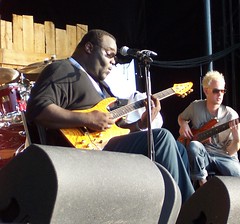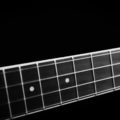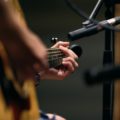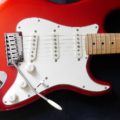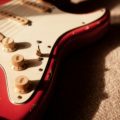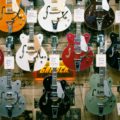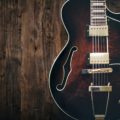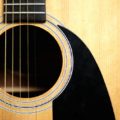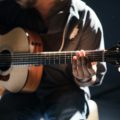One of the fundamental skills that a guitar player must master is playing chords. Although there are thousands of chord variations possible on the guitar, we’ll focus on a few standard beginner chords that can later be moved and modified to obtain more chords. These chords can be used immediately to learn simple guitar songs.
Different Types of Chords
There are many types of guitar chords, but ultimately there are two main types of chords in music: major and minor. Every chord can be classified into one of these two types. Major chords are built from major scales and have a “happy” sound, while minor chords come from minor scales and tend to have a “sad” sound. While some songs use only one type of chord, many songs and chord progressions combine major and minor chords. Let’s start with major chords.
Major Chords
Major chords are based on major scales and use the first, third, and fifth notes of the scale. We’ll start by focusing on five major chords: C, A, G, E, and D. Understanding guitar chords like these can open up a whole world of music Set Everything to Music - As a music enthusiast, you undoubtedly appreciate the excitement of discovering new artists, sounds, or instruments. Some people may have a preference for specific genres, such as classic rock, jazz, blues, pop, country, soul, classical, show tunes, or heavy metal, while others enjoy a diverse range of styles. Regardless of your taste, there's always something… for you. Each chord diagram below shows you where each string should be fretted, and with which finger. We’ll start with open chords, meaning that one or more open (not fretted) strings are included. Open strings are shown with a “0” in front of the first fret. Let’s take a look at G major, which contains the notes G, B, and D:
G Major
0 1 2 3 4 5
E|-|—|—|-4-|—|—|
B|-|—|—|-3-|—|—|
G|0|—|—|—|—|—|
D|0|—|—|—|—|—|
A|-|—|-1-|—|—|—|
E|-|—|—|-2-|—|—|
Note that you should place your middle finger all the way to the third fret of the bottom string, with the first finger on the second fret of the A string. Be sure to roll your wrist forward and curl your fingers so that all strings can ring clearly. Try picking just the A string: if you can’t hear that B note clearly, curl the middle finger a bit more so that it avoids the A string. This is a constant focus as you learn to play beginner guitar chords: all notes should ring clearly for it to sound good. Strum downwards with your pick, then upwards: you want all of the notes to sound as closely together as possible, so strum quickly.
You can also play G major with an open B string:
G Major
0 1 2 3 4 5
E|-|—|—|-3-|—|—|
B|0|—|—|—|—|—|
G|0|—|—|—|—|—|
D|0|—|—|—|—|—|
A|-|—|-1-|—|—|—|
E|-|—|—|-2-|—|—|
This shape is more popular in folk and country music About Country Music - For a long time in the 21st century, country music played a minor role within the pop music scene. Shortly after World War II, many new radio stations in urban areas focused primarily on this music, often accompanied by local advertising. In the 1930s, country's status was consolidated in the mainstream pop music landscape. The… , while the initial shape is more popular in rock music. This is because of the main third, which is B. When played on the high strings with an altered tone, the third can result in some unpleasant overtones. As you learn guitar chords, make sure to try playing them with different tones and pay attention to what sounds good to you. Also, practice getting your fingers in the correct positions as quickly as possible. Be patient: learning guitar Mastering the Guitar Fretboard - If you want to learn guitar at an advanced level, it's crucial to memorize the fretboard. This essential task greatly aids in mastering chords and scales. For example, consider a simple chord: C major. It consists of three notes: C (root), E (major 3rd), and G (5th). If you know the fretboard, you can play… chords takes time and practice. Focus on getting a clean sound from all notes and you’ll improve quickly.
Let’s look at another common chord, E major (E, G#, B):
E Major
0 1 2 3 4 5
E |-0-|—|—|—|—|—|
B |-0-|—|—|—|—|—|
G |—|-1-|—|—|—|—|
D |—|—|-3-|—|—|—|
A |—|—|-2-|—|—|—|
E |-0-|—|—|—|—|—|
The guitar E chord is easy to play, and all the strings are strummed. Pay attention to the fingerings, as learning incorrect fingerings now will develop bad habits that will hinder you later on. Now let’s look at A major:
A Major
0 1 2 3 4 5
E |-0-|—|—|—|—|—|
B |—|—|-3-|—|—|—|
G |—|—|-1-|—|—|—|
D |—|—|-2-|—|—|—|
A |-0-|—|—|—|—|—|
E |-x-|—|—|—|—|—|
Notice the ‘x’ on the low E string. That means the string shouldn’t be strummed. Although E is part of the A major chord (A, C#, E), the low E makes the chord sound too muddy and hides the A root note. So, after placing your fingers in the chord, pay attention to playing only the five best strings. Also, make sure you can hear the significant E string. This is one of the harder beginner guitar chords, as your fingers are in a small area. Stick with it, though, and follow the recommended fingerings.
When you can play A major, try switching between E major and A major. Take your time: a slow, clean transition with the notes sounding clearly will sound better than a bunch of missed notes and muted strings. Once you can move back and forth, try a simple beginner guitar rhythm: Strum E twice, then A twice, and so on. Start slowly, then try to increase the speed a bit. You’ll quickly see why the recommended fingerings should be followed: notice that the first finger stays on the same string and only moves one fret up, while the other fingers kind of jump around the first finger.
Now, let’s add another chord and try a trickier transition. Here’s C major (C, E, G):
C Major
0 1 2 3 4 5
E |-0-|—|—|—|—|—|
B |—|-1-|—|—|—|—|
G |-0-|—|—|—|—|—|
D |—|—|-2-|—|—|—|
A |—|—|—|-3-|—|—|
E |-x-|—|—|—|—|—|
To mute any unwanted sounds from the low E string, you can lightly touch it with your third finger while ensuring that the A string remains tightly pressed. Next, try strumming G twice, then C twice, and so on, but take it slow to achieve a clean tone. Keep practicing until you can switch between G and C chords smoothly.
Another open main chord to learn is D Major (D, F#, A):
D Major
0 1 2 3 4 5
E |—|—|-2-|—|—|—|
B |—|—|—|-3-|—|—|
G |—|—|-1-|—|—|—|
D |-0-|—|—|—|—|—|
A |-x-|—|—|—|—|—|
E |-x-|—|—|—|—|—|
You can add the open A string for more depth, or an F# on the low E string. To fret the F#, curl your thumb around the neck. This chord is challenging to play on many acoustics but is useful for playing hard rock genres on an electric guitar How to Buy a Guitar - The guitar is known for its dynamic and unique sound, making it a popular instrument in various genres of music. Whether you're a beginner or someone with a growing passion for guitar playing, here are some top tips for buying a guitar: Seek out advice. Start by seeking guidance from someone you know who has… . However, it’s not generally taught as a beginner chord.
Now that you know a few main chords, practice moving back and forth between them and experiment with which chords sound good together. You can also strum a chord four times, switch to another chord, strum it four times, switch to a third chord, strum it twice, and then go back to the second and first chords and strum each four times. Even if you don’t know how to read guitar notes, you can still create music.
The difference between main and minor chords is in the second note (the 3rd scale tone). In minor chords, the 3rd is a half-step lower than in major chords. For example, E major contains E, G#, and B, while E minor contains E, G, and B. Here’s the fingering for E minor:
E minor
0 1 2 3 4 5
E |-0-|—|—|—|—|—|
B |-0-|—|—|—|—|—|
G |-0-|—|—|—|—|—|
D |—|—|-3-|—|—|—|
A |—|—|-2-|—|—|—|
E |-0-|—|—|—|—|—|
As you learn guitar chords, compare the major and minor forms, paying attention to the sound of the chords and fingerings. A minor chord:
0 1 2 3 4 5
E |-0-|—|—|—|—|—|
B |—|-1-|—|—|—|—|
G |—|—|-3-|—|—|—|
D |—|—|-2-|—|—|—|
A |-0-|—|—|—|—|—|
E |-x-|—|—|—|—|—|
Notice how your second and third fingers ‘jump’ up one string from E minor. Try strumming back and forth between those two chords: it’s an easier transition that sounds great. Now let’s take a look at D minor:
D minor:
0 1 2 3 4 5
E |—|-1-|—|—|—|—|
B |—|—|—|-3-|—|—|
G |—|—|-2-|—|—|—|
D |-0-|—|—|—|—|—|
A |-x-|—|—|—|—|—|
E |-x-|—|—|—|—|—|
Note that the fingering is quite different from D major. That’s fine because it’s unlikely that you’ll move between those two chords in a song. As always, when practicing how to play beginner guitar chords, focus on clean sound and avoiding strings that shouldn’t sound.
The Barre Chord:
You’ve learned all the basic open chords, and practiced until you can move between them smoothly and even begin to learn easy guitar songs. Now it’s time to take on one of the more challenging beginner guitar chords: the barre chord. This is a chord form that can be played on any fret of the guitar because it doesn’t use any open strings. Instead, your index finger forms a bar across the fretboard, playing three notes at once. To make this work, you need to rotate your wrist way forward, get that finger as flat as possible, and really dig into the fretboard. Here’s what it looks like on the first fret, which gives you the F major chord:
F major barre:
0 1 2 3 4 5
E |—|-1-|—|—|—|—|
B |—|-1-|—|—|—|—|
G |—|—|-2-|—|—|—|
D |—|—|—|-4-|—|—|
A |—|—|—|-3-|—|—|
E |—|-1-|—|—|—|—|
In terms of learning guitar chords, this is the rite of passage: master the barre chord, and you’ve officially learned how to play beginner guitar chords. It isn’t easy, but don’t give up! Pick each string one at a time and make sure you can hear each note ring clearly. If the notes on the first finger aren’t clear, make sure the finger is flat and pressed tight against the strings. This is not a natural position, so don’t be discouraged if it’s not perfect at first. This will strengthen your fingers, improve your coordination, and make it easier to learn guitar chords that are more advanced.
Manuel Marino is a seasoned Senior Producer, Music Composer, and Artist with over a decade of experience. He specializes in branded entertainment across various mediums, including video games, films, and advertising campaigns. With 20+ years as a game music composer, Manuel has worked on numerous platforms, creating diverse orchestral soundtracks. HIRE ME


 Manuel is a passionate, driven, and techsavvy AV technician,
Manuel is a passionate, driven, and techsavvy AV technician, 